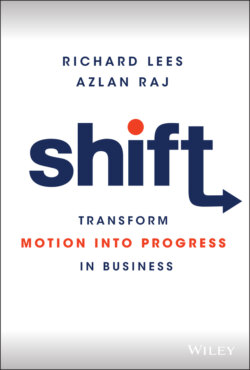Читать книгу Shift - Richard Lees - Страница 25
The aim is an adaptive organisation that can transform motion into progress
ОглавлениеAs a business, you might be working towards transforming your customer experience, but what we want to help you achieve is becoming an adaptive organisation. Why is that distinction important? Because there is no end. As we said earlier, this isn't a linear process with a final destination; it's a constant evolution.
The peppered moth that we talked about at the beginning of this chapter embodies that concept. Not only did the moths living in highly industrialised areas become darker in colour as their environment became polluted by the soot from factories, those same populations of moths have since returned to a lighter colour because a lot of the pollution that existed decades ago has been cleaned up. That species has continued to evolve to adapt to its current environment. A business is no different.
As a leader, you need to have a transformative mindset, which means that you're able to reframe your dream or vision for the business when required. Amazon's AWS service is a great example of this. It was initially developed as an internal system to manage Amazon's own infrastructure, but it quickly became clear that the technology had a multitude of applications that could be useful to a range of businesses. As a company, Amazon looked at AWS, recognised an opportunity to productise and monetise it, and then reframed what that meant for their business. Amazon adapted its offering and altered the direction of its business in the process.
Another way to look at this is through the analogy of buying someone a fishing rod versus teaching them how to fish. Imagine that each of the villages along a river represents a business. What often happens is that the people in one village look across the river and see that all the people in that other village are well fed. They look closer and see that they have fishing rods, so they go out and buy the same rods.
However, there is a difference between having the fishing rod and knowing where to find the fish, what bait to use, and how to start reeling them in when you do get a bite. Knowing how to fish is very different from having a fishing rod. What the people in that first village need to do is learn to fish, not buy fishing rods. Within business the same principle applies.
It can be easy to look at a competitor and think that if you have the same tools as it does, you'll get the same results, except this ignores all the knowledge that your competitor has. Our advice is to learn to fish instead of rushing to buy fishing rods, and our hope is that this book will help you to do that.
We often see businesses making this mistake in relation to technology: when an organisation will decide to change its technology because other businesses around it are doing the same. However, it's important to consider that changing your technology might not lead to the results you want. You have to ask whether you're using the technology you have correctly, how you can leverage what you've got, and whether you're driving the right value. Can you adapt how you're using your tools, rather than just throwing them out and buying new ones? Sometimes you will need new tools, but don't buy them because your competitors have them. Learn how to fish and decide if you need a rod or a net.
